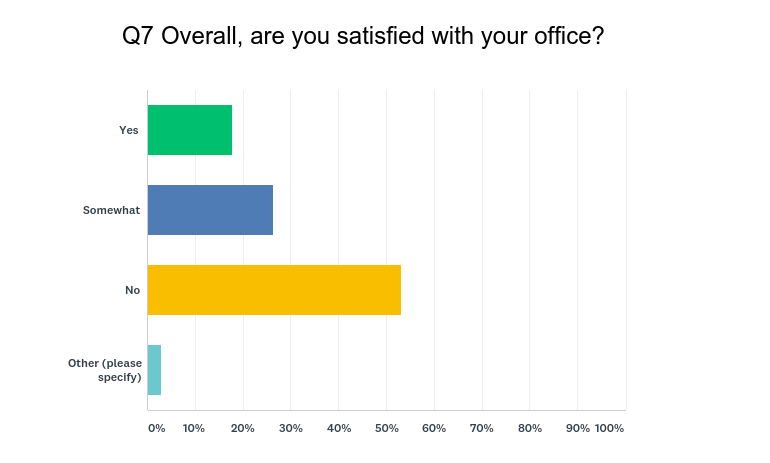
Exclusive
Despite open office trend, federal employees not thrilled with results
The General Services Administration and the agencies it partners with have reimagined the spaces where federal employees spend most of their work hours, but...
The General Services Administration and the agencies it partners with have reimagined the spaces where federal employees spend most of their work hours, but questions remain over whether they welcome the change.
In an exclusive Federal News Radio survey of more than 500 federal employees, the majority of agency workers who already work in an open office said they wouldn’t recommend the change, and the majority of employees whose agencies haven’t moved to an open office plan yet said they’re not looking forward to the change.

More than 44 percent of respondents said their agency office had adopted an open office design. Of those, 53 percent said they weren’t satisfied with their current workspace. Only 16 percent approved of the open redesign, and 26 percent said they were “somewhat” satisfied with the new layout.
“The plan was pushed through, despite there being no performance metrics to see if indeed productivity would rise,” one survey-taker wrote. “[Office] footprints indeed were reduced, as were productivity and efficiency.”
While 50 percent of survey respondents said they didn’t work in an open office design, 63 percent of those workers said they would be concerned if their agency moved to an open office design.
Several employees who took the survey said their agencies expect to move into an open office floor plan in the next couple of years.
New data raises new questions over open offices
Federal News Radio launched the survey following the release of studies that highlight some of the opportunities and challenges that come with open offices.
In August, the University of Arizona released a study, funded by the General Services Administration, that found federal employees working in open office environments were more physically active and less stressed than their colleagues in cubicles or private offices.
But a recent Harvard Business School study found that private-sector workers sharply reduced face-to-face interaction after moving to open offices.
One survey respondent agreed that their open office made them walk around more, but not to collaborate with colleagues.
“I do not thrive in an open floor plan environment. It is noisy, distracting and disrespectful of boundaries. I would prefer private offices with a door, or at the very least tall cubicles to allow people to work with focus. Some people feel it fosters collaboration. I feel I avoid people more because I literally can’t get away from them,” the respondent wrote. “I take walks outside the building to get a break, rather than eat lunch at my desk, etc. That’s why my activity level has increased. I’m not walking around talking to people — I’m walking away from the office to get some peace and quiet, and think.”
Feds find open offices less productive
In the Federal News Radio survey, 72 percent of employees already working in open offices said the new design made them less productive.
“It is terrible! No privacy, noise, constantly moving around losing productivity,” one respondent wrote.

Only 6 percent said the change made them more productive, and 14 percent said there was no change.
One respondent said their open office was “productive when doing heads down or collaborative work,” but found it unproductive when trying to listen to a phone call or conference call. In those cases, the respondent said they preferred to head to a team room or quiet space.
In addition, 68 percent of employees in open offices said the new layout didn’t lead to an increase in collaboration. More than 20 percent said collaboration did go up in their open offices.
Another 11 percent gave mixed reviews on collaboration.
“Works well with people you want to meet with, but also makes it easier for ‘drive-by’ interruptions,” one respondent said.
Another survey-taker said their office’s group spaces were regularly used for impromptu get-togethers.
Another respondent, who works on “sensitive contract matters,” said the open floor plan served as a hindrance to their work.
Noise complaints increased under open offices
The survey’s findings regarding productivity correspond with a perceived increased in noise distractions.
More than 83 percent of employees with open offices said their offices were generally noisier under the new design. More than 6 percent said the office was quieter, and another 6 percent said there was no change.

Casey Lindberg, the lead author of the University of Arizona study, said that open-office employees typically practice better “sound etiquette.”
However, one respondent said their agency uses a “sound masking system” that creates white noise to drown out neighboring conversations. The system, the respondent said, “sounds like an extra-loud A/C unit, but it does help cover conversations nearby.”
More than 42 percent said they had sufficient office space with an open design, but 27 percent said they didn’t have enough space, and another 26 percent said they wished they had more space.
“The space is poorly configured,” one respondent wrote. “I do not have a ‘desk’ area where I can fit my legs under the worktop.
When asked what they’d change about their offices, one respondent said they’d add low partitions to their workstations for added privacy. The current lack of partitions, they said, made employees feel constantly on display.
“Can’t change shoes, blow your nose, adjust clothing, etc without many eyes on everything. It’s very disconcerting, especially to women,” the respondent wrote.
Copyright © 2025 Federal News Network. All rights reserved. This website is not intended for users located within the European Economic Area.
Jory Heckman is a reporter at Federal News Network covering U.S. Postal Service, IRS, big data and technology issues.
Follow @jheckmanWFED
Related Stories





